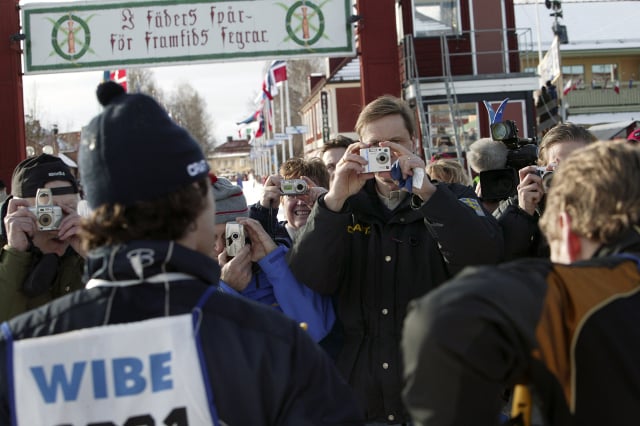A transition month, long on slush. Step outside in fine shoes at your own risk. But day and night hours will return to equilibrium about the 20th, and winter’s agonies are forgotten at the first sighting of yellow coltsfoot in a roadside ditch. By the end of the month, the crocus appears in the south. Crocuses don’t grow wild but almost every garden has them. This is a country poorly suited to gardening because of the temperature swings and short growing season, but everyone with a patch of land tries. Almost a hundred years ago, cities began setting aside plots for factory-working families to plant flowers and watch real grass grow. The huts on these allotments are legally limited in size to prevent their use as dwellings.
Bears are in their last month of hibernation (no, there are no polar bears in Sweden) but deer can occasionally be seen in city suburbs, nibbling at early tulip bulbs.
Long-distance or tour skaters are still plying the archipelagos, where virgin ice too thin to stand on will support you if you’re moving fast enough. Skaters say the ice will sing its thickness, warning you of danger, but it’s still safer earlier in the winter when the ice is sturdier. The hardest part must be the test dip: skaters’ clubs sometimes ask prospective members to jump into freezing water so they can practise getting out. Skaters carry a pair of ice prods on a string around their necks, handy for gripping the ice in case of a dunk; dry clothes in plastic bags can also serve as flotation devices. Once in the water, you’ve got 20 minutes at most. Ice-skating originated in Scandinavia about a thousand years ago, when some unnamed genius came up with the idea of tying polished bone to footwear.
Outdoor exercise, particularly in winter, underpins the population’s good health. The global battle between the couch and the great outdoors is being fought here too, although the toughening effect of a winter climate serves Sweden well. Almost everyone has at least stood on skis by the time they reach adulthood.
The pinnacle event of the skiing year is not a high-purse race involving slalom brand names but the world’s oldest mass ski race, the Vasaloppet, on the first Sunday of March. If there’s no snow, they’ll manufacture it. More than 4,000 skiers from dozens of countries compete. The race covers the 90 kilometres separating the towns of Sälen and Mora, recalling the 1521 flight of the renegade Gustav Vasa, later king, from Denmark’s Kristian. Kristian was known as ‘the Tyrant’ in Sweden but not in Denmark. Vasaloppet is a world-renowned event and a male rite of passage. The starting gun brings to life a mobile mosaic of thousands of battling skis and ski poles. Wool-covered heads bow to the snow and shoot like shotgun pellets into the forest. King Carl Gustaf and his son Prince Phillip have done the race, presumably both for its iconic thrill and to honour its royal history.
The monarchy enjoys continued popular support. But Swedish monarchs are restricted to opening bridges and parliament, with less power than any other European royal heads of state. The current royal dynasty is relatively young — in 1810 the government needed a replacement king sharper with money than the old one, and offered the throne to a wealthy French field marshal, Jean-Baptiste Bernadotte (aka King Karl XIV Johan). Paradoxically, some of the world’s most stable democracies are the monarchies of northern Europe.
Article written in 2010. The Year in Sweden by Kim Loughran is on sale at the AdLibris online bookstore.


 Please whitelist us to continue reading.
Please whitelist us to continue reading.
Member comments